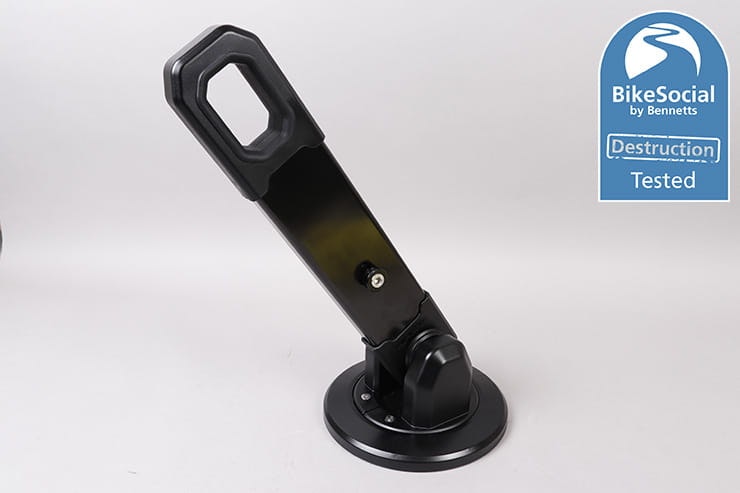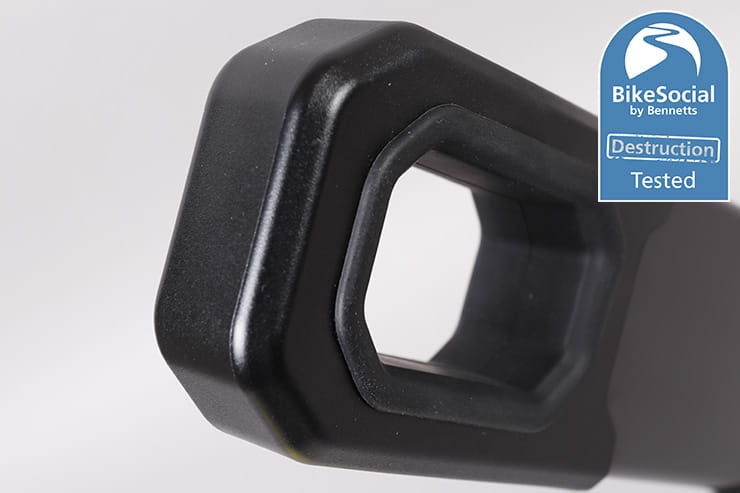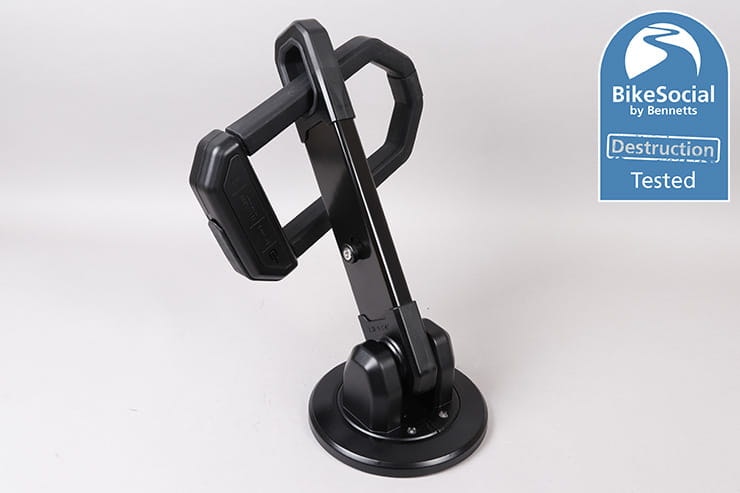Hiplok AX1000 review | Unique angle-grinder-resistant ground anchor
By John Milbank
Consumer Editor of Bennetts BikeSocial
08.11.2023
Date reviewed: November 2023 | Tested by: John Milbank | RRP: £350 | hiplok.com/1000-series
Motorcycle security has come a long way in the last few years thanks to the introduction of angle-grinder-resistant D-locks. Hiplok was the first, and it’s now released the new DX1000 (reviewed here) which is the biggest, most versatile and overall toughest lock we’ve tested, making it brilliant when out and about with your bike as it’s portable and secure.
But at home it’s always worth using a ground anchor, which usually means additional investment in a heavy-duty chain, lock and ground anchor. Now, with the launch of the AX1000 on review here, and the A1000 reviewed here, Hiplok has created a complete security package that can provide outstanding protection both at home and when you’re out and about…
Highly resistant to all forms of attack
Rotates and pivots to aid locking
Paired with DX1000 makes a great all-round solution
Must be carefully positioned when fixing
It’s important to wear proper protective equipment when using any tools, like these safety slippers
Fitting and convenience
The Hiplok AX1000 is a hefty beast. At its base, it’s the same as the A1000 reviewed here, which spins through 360°. But attached to the cross-beam is a steel and Ferosafe arm that can be rotated through 180° in the horizontal axis. It’ll lock in place with a cleverly-designed pin, but it can be tipped to any position between these stops if it helps you find the right place to lock up.
Using the Hiplok DX1000 D-lock with a traditional ground anchor or chain would mean they’re potentially the ‘weakest’ link in the set-up. Of course, a heavy-duty chain and anchor provide excellent resistance to attack, but a 22mm chain and large padlock can’t be carried with you when you’re out for a ride. The Hiplok DX1000 can, so by offering a dedicated angle-grinder-resistant ground anchor solution, you could potentially save money by using the same lock at home and away.
The Hiplok AX1000 has a 37x63mm loop to pass the D-lock through, which when upright sits 380mm from the ground (measured to the centre). The arm itself is 300mm from the pivot point to the centre of the loop. The DX1000 D-Lock’s shackle can rotate about 80° inside the loop in the horizontal axis, but twist only about 30° in the vertical axis, so there’s not the freedom of movement you’d have with a chain, meaning it’s important to work out exactly where’s best to fix the anchor.
The arm itself is 25mm thick and 70mm wide, with a steel sleeve covering a steel and Ferosafe core. The arm’s rotation locking mechanism is extremely solid, and doesn’t compromise the structural integrity due to the large amount of material surrounding it.
The loop at the end is covered with a plastic sleeve that’s held in place by a silicone insert. While looking for different locations to fix the anchor I did find this occasionally popped out, but it’s easy to reinsert. I also managed to tear it slightly with the end of the shackle, but it’s out of sight and only really decorative anyway.
The base of the anchor is held together with six M10 set-screws that are hidden under the plate once it’s fixed into the wall or floor. I added some thread-lock to these fasteners to ensure they couldn’t loosen off over time with constant knocking and vibration, but Hiplok tells me that this will already be done on the production versions.
I’ll stress again how important it is to spend a good amount of time finding the position that will work best for the Hiplok DX1000 D-lock to pass around your bike’s wheel, through the AX1000 anchor and then secure into the lock body. The front wheel is most likely the easiest point, or you could use a cast spoke or even potentially the frame. Having said that, I did manage to get the DX1000 around the ZX-6R’s rear wheel and through the AX1000 anchor.
Careful fitting is vital as once the AX1000 is installed using the eight supplied M10 expanding bolts – and the ball-bearings are driven into the bolt heads – it’s not going anywhere. A paper drilling template will be supplied with the production versions, and Hiplok provides a standard masonry drill bit with the anchor, though you’ll likely need a powerful mains-powered drill.
Take your time, and if you need to hire a heavy-duty drill for half a day, it’s worth it when fitting any anchor. I marked all the holes, then started each with a small masonry bit before moving onto the 16mm with my old Woolworth SBS impact drill. I then found it easiest to loosely assemble the bolts onto the anchor before lowering it all into place.
Each hole is more than two inches apart, and as long as the floor is good and solid, there are no issues with the integrity of the fixing. Accurate drilling is important, but I had it installed in less than an hour, with all eight bolts fitting easily.
Note: When installing expanding bolts into concrete, use a length of tube to blow all the dust out of the bottom of the hole; a vacuum won’t draw it all up.
Resistance to attack: bolt-croppers
Forget bolt-croppers – the sheer size of this kit means even the largest professional bolt croppers that we use for testing are unable to have any impact at all.
To see how this compares with the other locks we’ve tested, check out our best motorcycle locks for home and away.
Resistance to attack: sledge-hammer
Despite a sustained attack with a sledge-hammer, including at angles that would be impossible with the anchor fixed down, the AX1000 suffered nothing more than a few cosmetic dents under the shattered plastic covers.
I was concerned that the length of the arm would create a lever point that could help defeat it, but in practice the movement of the arm when striking it releases the locking pin and it simply folds down. But that’s with it not attached to the lock and the bike; in that situation, and given the resistance of the DX1000 D-lock to hammer attacks – the sledge-hammer remains unable to defeat it.
Incredibly, even after a brutal attack, the pivot and rotation mechanisms still works fine.
While I’m unable to try this myself, the ART certification required a pull test of seven tonnes, which means thieves prying or pulling it out of the ground also isn’t a real option.
To see how this compares with the other locks we’ve tested, check out our best motorcycle locks for home and away.
Resistance to attack: angle-grinder
At its narrowest point, the loop of the Hiplok AX1000 is 13x25mm, which is slightly larger in cross-sectional area than the DX1000 D-lock’s shackle. In practice it was slightly harder to cut through with abrasive discs than the shackle, though still taking taking three discs to make one cut. Of course, the only way to get the lock out is to make two cuts!
However, the anchor was a little quicker to cut than the DX1000 when using a diamond cutting disc. While this is counter to the idea that a ground anchor needs to be tougher than the lock, given the high resistance to attack of the D1000 this need not be a concern, especially as it was still a significant amount of work. Also, even if a thief does manage to cut the anchor’s loop, they’ll still have the lock itself to contend with; assuming it’s attached to the wheel, that remains a problem.
Attacking the body of the lock with a grinder is pointless, and highlights how Diamond cutting discs are not the terrifying tool to defeat all motorcycle security that social media portrays them as… I couldn’t get through the body of the anchor with either disc in any kind of reasonable time, but progress was noticeably slower with the diamond disc as they simply aren’t very effective on hardened steel.
The Hiplok AX1000 is Sold Secure Powered Cycle (formerly motorcycle) Diamond and ART 4 stars rated.
To see how this compares with the other locks we’ve tested, check out our best motorcycle locks for home and away.
I spent a lot of time looking for the best place to fit the AX1000 to my 1999 ZX-6R, as well as trying it on other bikes
Is the new Hiplok 1000 range right for you?
On its own, the Hiplok DX1000 D-lock has proven to be the overall toughest lock we’ve tested, and it’s also the most versatile thanks to its increased size over the previous D1000, and the competition. You can read a full destruction test review of the Hiplok DX1000 here.
As a piece of portable security, the DX1000 is an excellent investment, but at home, a ground anchor is an important addition to your security, and it’ll typically be used with a heavy-duty chain and lock, along with an anchor that should be harder to cut than the chain. You could use the Hiplok DX1000 with some carefully-positioned ground anchors, but then the anchor potentially becomes the weakest link due to the extreme angle-grinder resistance of the lock. That’s not to say that the best traditional chains and anchors are easy to cut by any stretch, but the benefit of the Hiplok system is that you can buy one lock that works with a dedicated ground anchor at home, and is also brilliant when out and about, potentially saving money over buying your home security completely separately.
However, the Hiplok system does require the anchor to be carefully positioned, and you have to work out how you’re going to use it. The DX1000 D-lock will just about fit over many rear wheels, but it can be a tight fit to get it around the anchor as well –it’ll depend on the bike.
The Hiplok AX1000 anchor can rotate 360° through the vertical axis, as well as 180° through the horizontal, which should mean you can find a position to get the DX1000 D-lock around the front wheel, a cast spoke on either wheel or even potentially sections of the frame, then lock it into the AX1000’s loop.
I’ve set the AX1000 up to lock the front wheel of my 1999 Kawasaki ZX-6R after trying various different positions. I could have got it to line up with the rear, but the anchor would take up the space I use to store some garage equipment.
It could be argued that thieves might take the front wheel off the Kawasaki, but removing the calipers, pinch-bolts, axle bolt and axle is a time-consuming hassle, not to mention then having to lug the bike clear and away. And as the bike’s close to the wall on one side, it’d also be very hard to do this.
I could of course use a heavy-duty chain and lock on the Kawasaki, but the point of the Hiplok is to provide both a home and portable solution.
On some motorcycles – particularly those with a trellis frame – you might be able to get the DX1000 D-lock through the frame and the AX1000 anchor, though I haven’t been able to with my R1250GS as it’d need to be on the side-stand side, and the subframe is quite cluttered here. On the other side the AX1000 isn’t long enough to reach where I could fit the D-lock.
Measure your set-up carefully to decide what works for you, but if you’re a push-bike or e-bike owner, the AX1000 is almost certainly a perfect option as you can easily mount it to the floor and pass the lock around the bottom bracket of your bicycle.
To see how this compares with the other locks we’ve tested, check out our best motorcycle locks for home and away.
Product: Hiplok A1000 ground anchor
Bolt cropper attack: PASS
Sledge hammer attack: PASS
Angle grinder attack: OUTSTANDING
Hiplok AX1000 ground anchor review: Verdict
As part of a complete home and away security package, the Hiplok AX1000 ground anchor, when combined with the DX1000 D-lock, makes for a truly formidable package.
It’s easy to take for granted the high resistance to angle-grinder attacks that some of the thickest chains and now portable security are achieving, but Hiplok has come up with a unique and innovative method of allowing one lock to do it all. And thanks to the relatively high resistance to a diamond disc attack, and the larger size making the DX1000 more versatile, this is a great package that’s well worth considering.
If you’d like to chat about this article or anything else biking related, join us and thousands of other riders at the Bennetts BikeSocial Facebook page.
Full attack test of the Hiplok 1000 range
See the DX1000, A1000 and AX1000 thoroughly tested



